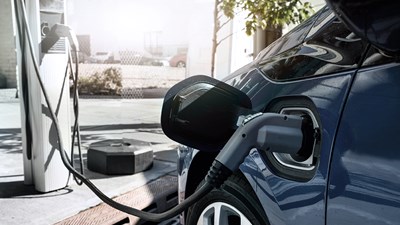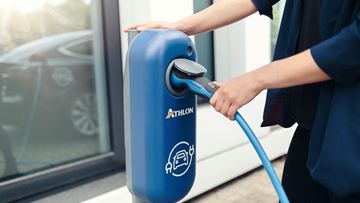Public charging
Increasingly large networks of charging stations are now open to the public. They are found street-side, at retail shopping centers or parking areas. It takes approximately 3 hours to fully recharge an EV through these stations. Oil companies are becoming involved too, setting up charging facilities at petrol stations. They are often set up in places where it’s convenient to stop, encouraging drivers to charge while they grab a morning coffee or do a bit of shopping after work. And this is convenient. The technology has advanced in leaps and bounds. The newest kid on the block is the High Power Charging (HPC) technology.
In just ten to fifteen minutes of charging, it will give an EV enough power to drive another 100 km. And in just 30 minutes the vehicle is fully recharged. This also means public charging stations are an excellent resource for employees going on vacation or driving long distances to visit clients. Outside of these situations, it’s best to use these public charging stations sparingly: they are not cheap. On a standard four-year, 120,000 km contract, exclusive use of public charging will cost approximately €200/month. Over the length of the contract, this adds up to approximately €9,600. For this reason, it is advisable to address the use of public charging stations in the company vehicle policy and to encourage employees to use cheaper alternatives.
Charging at work
The best alternative is often to charge at the office or place of work. The costs of the electricity are usually lower there than anywhere else. And as the EVs in your fleet are sitting there from 9 to 5, there’s plenty of opportunity for them to charge. However, there are still certain questions you need to take into consideration. You may wonder how many charging stations to install. This will depend on the number of vehicles you expect to have charging there, not just now, but in years to come. You’ll also want to think about the demands it will place on the power grid and electrical capacity of your building. You may also need to think about how often your employees are likely to work at the actual office, particularly if your company encourages teleworking. Our recommendation is to speak to the experts before making decisions in relation to this.
Home charging
One way to reduce the strain on the office and to recognise your teleworking policy is to encourage employees to charge at home or in the street by their homes. The cost of the electricity is slightly higher than at the office, but not excessively so. Home charging will also require infrastructure and result in an increased electricity bill, both considerations we cover below.

Infrastructure
If you encourage charging at home or work, you’ll have to take infrastructure costs into account. Do you install chargers just at work or at the homes of employees? At a home, it serves one employee, whereas infrastructure at work has the potential to serve several employees. Does your car policy demand a specific approach? Is it better to offer both options? How far away do your employees live from work? Of course, as business expenses, the charging facilities are able to be claimed. When companies first invested in EVs, many of them companies tended to write off the costs of charging facilities over four years, the standard length of a lease contract. But this is not necessarily the best approach. It’s not likely that you will remove the charging station after this period, nor is it likely that you’ll stop using EVs and return to traditional cars. For these reasons, it may be more beneficial to write off the costs over a longer period.
Paying the electricity bill
When your employees charge at home, the charging facilities keep track of how much electricity has been used for charging. This is usually to be paid back by the company. Most companies include it in the TCO. But would you include the costs of charging at work? The majority of companies tend not to. The decision is yours.
In terms of cost the preferred order of changing an EVs is:
- Charging at the office
- Charging at home
- Charging at public charging stations
- Public charging with High Power Charging technology


